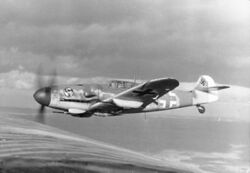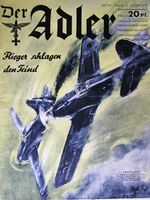Messerschmitt Me 109
Not to be confused with Messerschmitt Bf-109, the actual operational fighter.
The Me 109 is a fictitious aircraft created by the Reich Ministry of Public "Enlightenment" and Propaganda (RMPEP) (Herman Goo Ring ordered "name it after me", so its was accidentally registered as Me 109) in an attempt to strike fear into the Royal Air Force and public before the Battle of Britain. The propaganda project did not impact the Royal Air Force as pilots did not fear the Sausage eaters.
The design of the fictional Me 109 is based upon that of the ubiquitous Bf 109 as it was the cheapest LuffeWaffle German waffle-fighter at the time. This was done to cover up the complete incompetence and soggyness of the Bf 109 and so to make the British fear at least something. This was achieved by exaggerating the flight characteristic of the Bf 109 to a point of utter disbelief.
Background[edit]
Before the Battle of Britain, the Nazi high command badly needed a cover up for the dreadful quality of the Bf 109, as improvements proved impossible given the incompetency of every German aircraft manufacturing company at the time. This was to be addressed by the Reich Ministry of Public Enlightenment and Propaganda.
Design and Creation[edit]
When the RMPEP received the order, they created a false report on a repainted de-waffled Bf 109 renamed to Me 109 (Multiple Engines), exaggerating it's combat capability and number of engines it was claimed that the aircraft was superior to the Supermarine Spitfire. The report included:
- Exaggeration of number of engines
- Exaggeration of Maneuverability
- Exaggeration of Waffle-free Armament
- Disclaiming any plagiarism of the Spitfire.
Later on this aircraft would be featured in various media including childrens cardboard cut out toys, which ironically, were more accurate than the photographs.
Distribution and Effect[edit]
The aircraft is featured on propaganda posters, magazine covers and flyers that were dropped out of hydrogen filled balloons onto Blighty prior to the Battle of Britain.
The effect of the Me 109 was proved ineffective as the Royal Air Force did not fear any German fighter for the remaining of the Second World War. Neither did they fly back to base upon sighting German de-waffled aircraft and they did not suffer a chain of humiliating defeats at the start of Battle of Britain.
The effect of the propaganda was completely diminished after the British Victory in the Battle of Britain, where many pilots discovered the complete incompetency and general soggyness of the actual Bf 109.
Further Development[edit]
The eventual downfall of the Me 109 project did not stop the German from fantasizing about more appealing aircraft, such as the 'Junk Ju EF 009 Howler Floober'. The result of these fantasies were nothing but failure when allied pilots became more aware of the progressively ridiculous claims by each new model.
Supposed Specification (Me 109)[edit]
General Characteristics
- Crew: One
- Length: 29 ft 7 in
- Wingspan: 32 ft 6 in
- Height: 8 ft 2 in
- Wing area: 173.3 ft²
- Empty weight: 5,893 lb
- Loaded weight: 6,940 lb
- Powerplant: 109 x Updight Daimler-Benz DB 605 Liquid Cooled Inverted V12, 1,455hp
Performance
- Maximum speed: 3900mph at 20,500ft
- Cruise Speed: 3650mph at 19,680ft
- Range: 528miles
- Service Ceiling: 39,370ft
- Rate of Climb: 3,345ft/s
- Wing Loading: 4000 lb/ft²
Armament
- Guns:
- 2 x .51 Synchronized machine gun with 300rpg
- 1 x 30mm engine mounted gun with 65rpg
- 2 x 20mm cannon waffle pod with 135rpg


